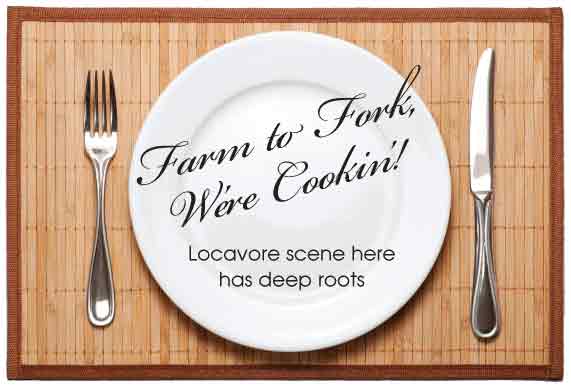
Women in the Triangle were filling their kitchens with fresh, seasonal produce for decades before the term “locavore” (those who prefer eating food that’s produced nearby) was coined. After all, the Carrboro Farmers’ Market is celebrating its 31st year!
But all of a sudden, we’re getting national attention. In the past few months, The New York Times published several articles about the locavore action in the Triangle.
“Durham, a Tobacco Town, Turns to Local Food” shouted a headline on the cover of the newspaper’s Dining section.
“Hundreds of outlying acres of rich Piedmont soil have ‘transitioned’ from tobacco, and now sprout peas, strawberries, fennel, artichokes and lettuce,” the article proclaimed.
“Animals also thrive in the gentle climate, giving chefs access to local milk, cheese, eggs, pigs, chickens, quail, lambs and rabbits.”
Inside, an entire page full of photos toasted the revitalization of Durham’s downtown, suggesting it’s a tasty change due to restaurants using ingredients that didn’t travel far.
“Fresh Direction: A Farm-to-Table Restaurant,” a multi-page piece that ran in The New York Times Magazine, also cheered the market-to-mouth movement.
The owners of Coon Rock Farm — “55 acres of just about everything you can grow and raise” — in Hillsborough, plan to evolve the farmer’s market into the farmer’s restaurant, The Times crowed.
“Eno, which is scheduled to open early this summer in downtown Durham, will serve dishes made from Coon Rock’s meat, vegetables, eggs and milk (including from a cow named Eudora — as in Welty),” the magazine said.
“Toward the end of the meal, diners will be handed a dessert menu and a market menu. Liked the pork chop and Russian kale? Take some home and cook them your way.”
The creators of the farm and the planned eatery also own Zely & Ritz, an organic bistro in Raleigh’s Glenwood South that specializes in small plates of upscale food fashioned with local ingredients.
“Making Delis a Cut Above by Rewriting Menus With Local Foods,” another Times article, counted Neal’s Deli in Carrboro among those places that “have responded to the low standard of most deli food — huge sandwiches of indifferent meat, watery chicken soup and menus thick with shtick — by moving toward delicious handmade food with good ingredients served with respect for past and present.”
Locavore sentiment in the Triangle has been nurtured by the increase in farmer’s markets as well as the advent of community-supported agriculture, or CSA.
North Carolina boasts a bounty of almost 150 farmer’s markets and a similar number of farms that participate in CSA by growing produce for “shareholders,” people who pay in advance for a portion of the harvest.
These shareholders receive a box of natural goodness that they typically pick up once a week at an urban drop site or the farm itself.
The summer here is ripe with fruit and vegetables, so why reduce these stars of the locavore scene to second bananas? Move the veggies center stage with these recipes for main dishes from recent cookbooks. Then bring out the two fruity desserts to a round of applause.
 Farmers Market Cookbook: A Fresh Look at Local Flavor
Farmers Market Cookbook: A Fresh Look at Local Flavor
by Southern Living
Published by Oxmoor House
Summer Squash Casserole
1-1/2 pounds yellow squash
1 pound zucchini
1 small sweet onion, chopped
2-1/2 teaspoons salt, divided
1 cup grated carrots
One (10-3/4 ounce) can cream of chicken soup
One (8 ounce) container sour cream
One (8 ounce) can water chestnuts, drained and chopped
One (8 ounce) bag herb-seasoned stuffing
1/2 cup butter, melted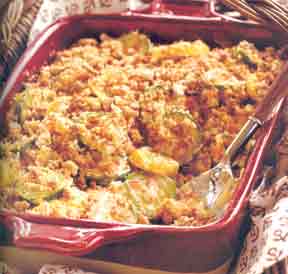
Preheat oven to 350 degrees. Cut squash and zucchini into 1/4-inch-thick slices; place in a Dutch oven. Add chopped onion, 2 teaspoons salt and water to cover. Bring to a boil over medium-high heat, and cook 5 minutes; drain well.
Stir together grated carrots, next 3 ingredients and remaining 1/2 teaspoon salt in a large bowl; fold in squash mixture. Stir together stuffing and melted butter; spoon half of stuffing mixture into bottom of a lightly greased 13- x 9-inch baking dish. Spoon squash mixture over stuffing mixture, and top with remaining stuffing mixture.
Bake at 350 degrees for 30 to 35 minutes or until bubbly and golden brown, shielding with aluminum foil after 20 to 25 minutes to prevent excessive browning. Let stand 10 minutes before serving.
Makes 8 servings.
Frogmore Stew
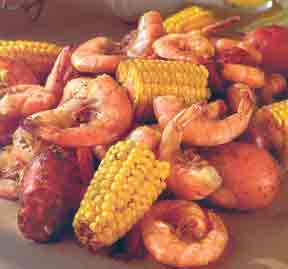
1/4 cup Old Bay Seasoning
4 pounds small red potatoes
2 pounds kielbasa or hot smoked link sausage, cut into 1-1/2-inch pieces
6 ears fresh corn, halved
4 pounds unpeeled large fresh shrimp
Old Bay Seasoning for serving
Cocktail sauce for serving
Bring 5 quarts of water and 1/4 cup of Old Bay Seasoning to a rolling boil in a large, covered stockpot.
Add potatoes; return to a boil, and cook, uncovered, 10 minutes.
Add sausage and corn, and return to a boil. Cook 10 minutes or until potatoes are tender.
Add shrimp to stockpot; cook 3 to 4 minutes or until shrimp turn pink. Drain. Serve with Old Bay Seasoning and cocktail sauce.
Makes 12 servings.
 Tomato: A Fresh-From-the-Vine Cookbook
Tomato: A Fresh-From-the-Vine Cookbook
by Lawrence Davis-Hollander
Published by Storey Publishing
Pasta With Tomatoes, Garden Vegetables and Crumbled Blue Cheese
Blue cheese brings extra panache to this popular team of summer garden vegetables.
Two (7- to 8-inch) Chinese or Japanese eggplants, diagonally cut into 1-inch slices
Salt
12 ounces rotelle, penne or other medium-size pasta
2 tablespoons extra-virgin olive oil
2 green or red bell peppers, seeded and cut into 1/2-inch strips
1 large onion, quartered and sliced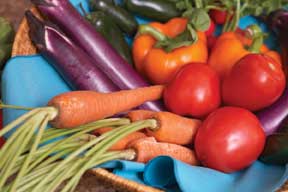
2 garlic cloves, peeled and slivered
10 plum or paste tomatoes or other firm tomatoes, peeled, seeded,
and quartered
2 medium summer squash, diagonally cut into 1/2-inch slices
1 medium zucchini, diagonally cut into 1/2-inch slices
1-1/2 teaspoons chopped summer savory
6 basil leaves, torn, plus 3 or 4 small sprigs for garnish
Freshly ground black pepper
2 teaspoons balsamic vinegar
4-6 ounces Roquefort, Stilton, Danish Blue or other blue cheese, crumbled
Layer the eggplant slices in a colander, sprinkling them with 2 tablespoons salt as you do. Leave the slices standing in the sink for 45 minutes, then rinse off the salt and pat dry.
Bring a large pot of water to a boil. Add a tablespoon of salt and then stir in the pasta. Boil the pasta for 8 minutes, or according to the package directions, until just al dente. Drain and keep warm.
While the pasta is cooking, heat the oil in a large skillet over high heat. Add the eggplant, peppers, onion and garlic. Reduce the heat to medium and sauté the vegetables for 2 minutes.
Stir in the tomatoes, summer squash and zucchini. Add the summer savory and basil, and season to taste with salt and pepper. Saute for 5-6 minutes, until the vegetables are tender, stirring and raising the heat if necessary to cook the vegetables briskly. Stir in the vinegar and cook for 1 minute longer.
Serve the pasta on a large platter with the sauteed vegetables piled on top. Scatter the blue cheese over the vegetables. Garnish with the basil sprigs.
Makes 4 servings.
Eggplant Parmigiana
When tomatoes are in season, so are eggplants. This dish is a partnership of three equal ingredients: eggplant, tomatoes and cheese.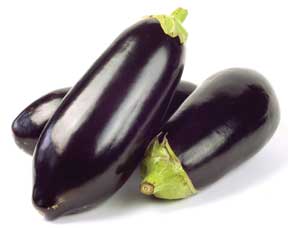
2 pounds eggplant, cut into 1/4-inch slices
Salt
3/4 cup all-purpose flour
1/2 cup olive oil
4 cups marinara sauce or other well-seasoned tomato sauce
Freshly ground black pepper
3/4 pound mozzarella, shredded or thinly sliced
3/4 cup freshly grated Parmesan cheese
1/2 cup chopped parsley
2 teaspoons dried oregano or 2 tablespoons fresh basil
Layer the eggplant slices in a colander, sprinkling them with salt as you do (use a total of 3 tablespoons salt). Let stand for 45 minutes, until beaded with moisture, and then rinse and pat dry with paper towels.
Preheat the oven to 375 degrees and grease a 9- x 13-inch baking dish.
Dip the eggplant slices in the flour and shake off any excess. Heat half the oil in a large skillet and brown the eggplant slices, a few at a time, over medium heat, for 3-5 minutes per side, until golden on both sides. Drain the cooked slices on paper towels while you proceed. Replenish the oil in the skillet as needed.
To assemble the eggplant parmigiana, put just enough tomato sauce into the baking dish to cover the surface. Add a layer of eggplant and season it with pepper and a little salt. (You won't need much salt, because the cheese is already salty.) Sprinkle on about one-third of the mozzarella, one-third of the Parmesan, half the parsley and half the oregano. Add about half the remaining tomato sauce and another layer of eggplant, seasoning, herbs and half the remaining cheeses. Cover with the last of the tomato sauce and a final layer of Parmesan and mozzarella.
Cover the dish with foil, and bake for 20 to 25 minutes, until bubbly. Remove the foil and bake for 5 minutes longer.
Let the dish rest for 4-5 minutes before serving.
Note: You can assemble the dish 4-6 hours ahead and bake later.
Makes 4-6 servings.
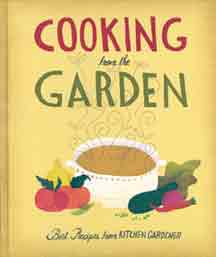 Cooking From the Garden: Best Recipes From Kitchen Gardener
Cooking From the Garden: Best Recipes From Kitchen Gardener
Edited by Ruth Lively
Published by The Taunton Press
Collards & Andouille Sausage Casserole
Collards are a quintessentially Southern vegetable. This casserole combines them with another Southern favorite, cornbread. Fresh from the garden: sweet onion, bell peppers, celery, garlic and collards.
For the filling:
1/4 cup peanut oil
1/2 pound andouille sausage (or Italian sausage or Portuguese lunguica), quartered lengthwise then cut crosswise into 1/4-inch pieces
1 cup sweet onion, diced small
1/2 cup red bell pepper, seeded and diced small
1/2 cup green bell pepper, seeded and diced small
1/2 cup celery, diced small
1/4 cup chopped garlic (about 7 cloves)
1 teaspoon crushed red pepper flakes (optional)
3-1/2 pounds young collards, cleaned, stemmed and cut crosswise into
1-inch pieces
3-1/2 cups chicken stock or water
Apple-cider vinegar
Salt and freshly ground black pepper
Hot sauce
For the cornbread:
1 cup stone-ground yellow cornmeal
3/4 teaspoon salt
1 teaspoon sugar
1/8 teaspoon baking soda
1-1/2 teaspoons baking powder
2 eggs
1 cup buttermilk
1 tablespoon melted butter
1 tablespoon melted bacon fat or an additional 1 tablespoon melted butter
Preheat the oven to 350 degrees.
To make the filling:
In a heavy-bottomed, 4-quart pot, heat the oil over medium heat. Add the sausage and cook over medium-low heat until browned. Remove the sausage to drain, leaving the fat in the pot.
Add the onions, peppers and celery to the pot. Cook over medium heat until softened and lightly colored. Add the garlic and pepper flakes, and cook for 1 more minute. Add the collards in 2- to 3-cup increments, and stir to wilt. Continue adding collards until all are wilted. Add the chicken stock and bring to a simmer. Cook over low heat, adding additional stock or water if necessary, until the collards are tender, about 20 minutes.
Season to taste with vinegar, salt, pepper and hot sauce, if desired. Be cautious with the pepper and pepper sauce if the andouille sausage is spicy. Stir in the reserved sausage and transfer the mixture to a 9- x13-inch casserole dish.
To make the cornbread:
In a large bowl, combine the cornmeal, salt, sugar, baking soda and baking powder.
In a second bowl, whisk the eggs, then whisk in the buttermilk, melted butter and melted bacon fat. Fold the egg mixture into the cornmeal mixture until well combined. Spread the cornmeal mix on the surface of the greens until the casserole is covered to the edges.
Bake until the cornbread is set and a toothpick inserted into it withdraws clean, approximately 30 minutes. Cool slightly before serving.
Makes 10 servings.
Turkish Stuffed Peppers
This dish is fresh, exotic and delicious. Serve it hot or let the peppers cool to room temperature. Fresh from the garden: bell peppers, peppers, onions, garlic, coriander seeds, oregano and mint
.
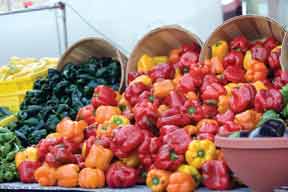
3 cups cooked white rice, cooled
8 green, red or yellow bell peppers, or a combination
2-1/2 tablespoons olive oil, more for garnish
2 medium onions, chopped
4 cloves garlic, chopped
Salt
Freshly ground pepper
2 teaspoons ground coriander
2 teaspoons ground cumin
2 tablespoons dried oregano
1 teaspoon cinnamon
1 cup cashews or walnuts, chopped
1 cup dried currants or raisins
1 cup chopped dried apricots
1/4 cup plus 2 tablespoons chopped fresh mint
1/4 cup freshly squeezed lemon juice, more for garnish
Dash cayenne
2-1/2 cups tomato sauce, homemade or canned
Fresh mint for garnish
Preheat the oven to 400 degrees.
Place the cooled rice in a large bowl, stirring to separate the grains. Cut the tops off the peppers and use a small knife to remove the ribs and seeds from inside the peppers, being careful not to pierce the skins. Very carefully, cut a thin slice off the bottom of each pepper so they sit flat.
In a large frying pan, heat 1-1/2 tablespoons olive oil over moderate heat. Add the onions and half the garlic, season with salt and pepper, and sauté, stirring occasionally, for 8 minutes. Add the coriander, cumin, oregano, cinnamon and the remaining tablespoon of oil, and cook for 30 seconds. Stir in the nuts, the remaining garlic, currants, apricots and 1/4 cup of the mint, and cook until the scent of the spices is released into the air, about 5 minutes.
Add the onion-spice mixture to the rice and stir well. Add the remaining mint, the lemon juice and cayenne; taste for seasoning.
Divide the mixture among the 8 peppers, pressing down on the stuffing to pack well. Place the stuffed peppers in a shallow roasting pan and top with half the tomato sauce. Add the remaining sauce and 1⁄2 cup water to the bottom of the pan and bake about 45 minutes. Baste the peppers with the sauce once or twice.
If the sauce appears to be drying out, add 1/2 cup water. Serve hot, or at room temperature, drizzled with olive oil and lemon juice and garnished with the mint.
Makes 8 servings.
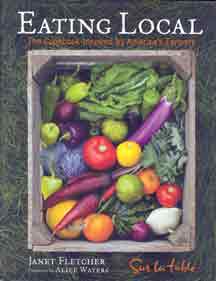
Eating Local: The Cookbook Inspired by America’s Farmers
By Janet Fletcher
Published by Andrews McMeel Publishing
Blueberry Clafouti
A classic from rural French kitchens, clafouti (pronounced “clah-foo-tee” with every syllable accented evenly) is traditionally made with fresh cherries. But when the blueberry season gets under way, this homespun dessert should be top of mind again. Resembling a cross between a custard and a puffy pancake, clafouti comes together quickly and is best when still warm. Try one for a weekend breakfast or brunch in place of waffles or pancakes.
1 teaspoon unsalted butter, softened
1/3 cup plus 1 tablespoon granulated sugar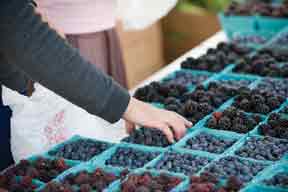
3/4 pound blueberries (about 2-1/2 cups)
3 large eggs
1 cup whole milk
1/2 cup unbleached all-purpose flour
1/2 teaspoon vanilla extract
1/4 teaspoon almond extract
Pinch of kosher or sea salt
1/4 cup sliced almonds, toasted
Confectioners' sugar, for dusting
Preheat the oven to 325 degrees. Using the butter, grease the bottom and sides of a 9- x 2-inch round baking dish, or another low-sided baking dish with a 11⁄2 quart capacity. Sprinkle the bottom and sides with the 1 tablespoon granulated sugar.
Put the blueberries in the prepared dish in an even layer.
Put the eggs, milk, flour, vanilla and almond extracts, salt and the remaining 1/3 cup granulated sugar in a blender. Blend until smooth. Pour carefully over the berries so as not to dislodge them. Scatter the almonds over the surface.
Bake until the clafouti is puffed and firm to the touch, about 35 minutes. Cool on a rack for about 20 minutes, then dust thickly with confectioners' sugar. The clafouti is best when served warm.
Makes 6 servings.
Grilled Pound Cake With Strawberry-Rhubarb Sauce
Many fans of pound cake know that toasting it heightens the cake's buttery flavor. Grilling works the same magic, so when you have the grill going for a summer dinner, why not grill dessert, too? Be sure to brush the grill rack clean first.

For the pound cake:
1 cup (2 sticks) unsalted butter, softened, plus more for preparing the pan
2 cups sifted unbleached all-purpose flour, plus more for preparing the pan
1⁄2 teaspoon kosher or sea salt
1⁄4 teaspoon baking powder
11⁄2 cups sugar
5 large eggs, at room temperature
1 tablespoon freshly grated lemon zest
1 tablespoon poppy seeds
For the strawberry-rhubarb sauce:
1 pint strawberries, cored and quartered lengthwise
1⁄2 pound rhubarb, trimmed and cut crosswise into 1⁄2-inch pieces
2 tablespoons fresh orange juice
6 to 8 tablespoons sugar
Mascarpone or vanilla ice cream
To make the cake:
Preheat the oven to 325 degrees. Lightly grease a 9x5x3-inch loaf pan with butter. Coat the bottom and sides with flour and shake out the excess.
Sift together the flour, salt and baking powder into a medium bowl.
In the bowl of a stand mixer fitted with the paddle, or in a large bowl with a handheld mixer, cream the butter on medium speed until smooth. Add the sugar gradually, beating constantly until the mixture is light and fluffy.
Beat in the eggs, one at a time, beating well after each addition and scraping down the sides of the bowl once or twice, then beat in the lemon zest and poppy seeds. On low speed, add the dry ingredients gradually, beating just until blended. Transfer the batter to the prepared pan, spreading it evenly.
Bake until the cake is firm to the touch and beginning to pull away from the sides of the pan, about 1-1/4 hours. A cake tester inserted in the middle should come out clean. Cool the cake in the pan on a rack for 15 minutes, then invert onto a rack. Invert again so the top is up, and finish cooling on the rack.
To make the strawberry-rhubarb sauce:
Put the berries, rhubarb, orange juice and 6 tablespoons sugar in a medium saucepan. Set over moderate heat and heat, stirring until the sugar dissolves. Cover, adjust the heat to maintain a gentle simmer, and cook, stirring occasionally, until the fruit softens and forms a sauce, about 10 minutes.
Keep a close eye on the saucepan, reducing the heat if the mixture threatens to bubble over. Cool slightly, then taste and add more sugar if desired. Transfer to a bowl, cover and chill thoroughly.
Prepare a moderately hot charcoal fire or preheat a gas grill to medium-high (375-400 degrees). Cut the ends off the cake, then cut the cake into 8 equal slices. Grill directly over the coals or gas flame, turning once, until lightly toasted on both sides, about 2 minutes per side.
Put about 1/3 cup of the sauce on each dessert plate. Top with a slice of toasted cake and a scoop of ice cream. Serve immediately.
Makes 8 servings.